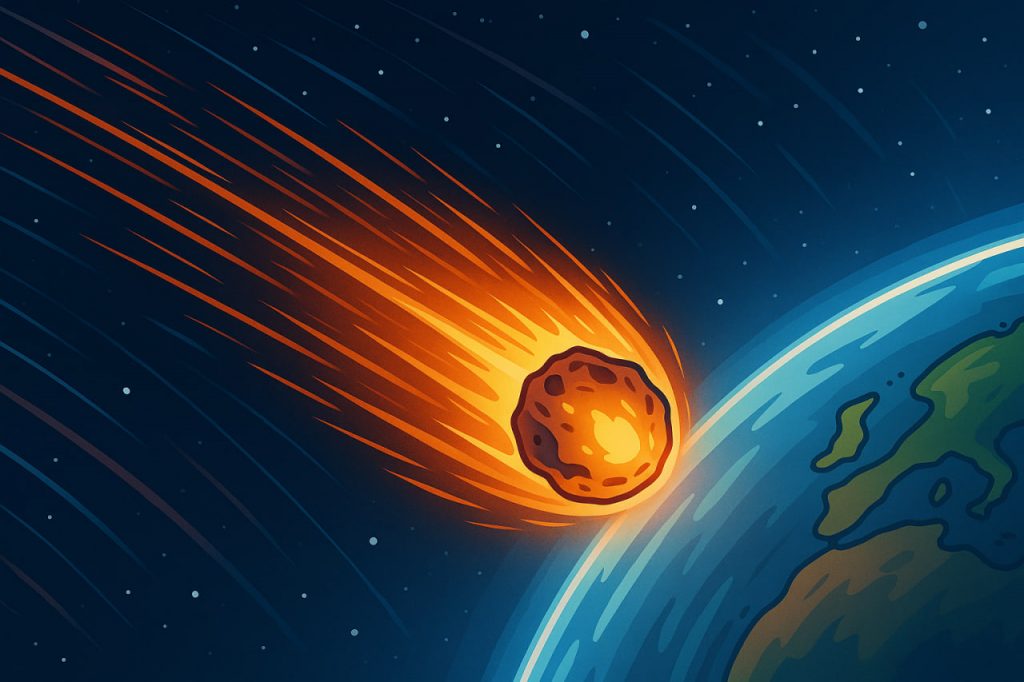Few cosmic events capture the imagination like the idea of a tiny object traveling at a velocity close to the speed of light and colliding with our planet. At first glance, a pebble seems harmless—barely capable of denting a windowpane. But if that same pebble were moving at relativistic speed, its impact would unleash an explosion of unimaginable power. This hypothetical scenario blends physics, astronomy, and relativity into one mind-bending thought experiment that demonstrates how energy and matter become interchangeable when pushed to cosmic extremes.
The Physics of Relativistic Speed
When an object approaches the speed of light—approximately 299,792 kilometers per second (186,000 miles per second)—its kinetic energy increases exponentially. According to Einstein’s theory of relativity, energy and mass are equivalent (E = mc²). This means that even a small mass can store an astronomical amount of energy if accelerated to relativistic velocity. A pebble weighing just 1 gram moving at 99.9999% of the speed of light would have an energy release comparable to a large thermonuclear bomb upon impact. Essentially, the rock becomes a bullet made of pure energy.
The Scale of Destruction
The result of such an impact would depend on the pebble’s exact speed and trajectory, but even a single gram of matter could devastate an entire region. On collision, the kinetic energy would instantly convert into heat, radiation, and shockwaves, vaporizing the surrounding material and excavating a massive crater. The explosion could be equivalent to tens or hundreds of megatons of TNT, potentially rivaling the most powerful nuclear weapons ever created. If the object were larger—say, the size of a marble—the devastation could reach planetary levels, disrupting the atmosphere and triggering global climatic effects.
Comparison to Asteroid Impacts
For perspective, the asteroid that caused the extinction of the dinosaurs released about 100 trillion tons of TNT worth of energy, roughly 10 billion times more powerful than the Hiroshima bomb. A relativistic rock, though smaller, would pack far more energy per gram. Unlike a typical asteroid, which relies on mass for destruction, this tiny projectile uses velocity to amplify its impact. Its high-speed entry through the atmosphere would produce an enormous burst of radiation, possibly resembling a brief gamma-ray explosion, visible from space.
Could Such an Event Actually Happen?
In nature, achieving such extreme speeds is almost impossible for macroscopic objects. Even the fastest cosmic rays—subatomic particles accelerated by supernovae or black holes—approach light speed, but they are tiny, smaller than atoms. A pebble-sized object would require more energy than humanity could ever produce to accelerate it even to a fraction of light speed. The only plausible sources capable of imparting that much energy are supernova explosions or active galactic nuclei. If such an object somehow reached Earth, it would likely annihilate itself—and part of our planet—on impact.
The Role of Relativity
At relativistic velocities, strange things happen to matter. From an outside observer’s viewpoint, the pebble would experience length contraction, appearing flattened in the direction of motion. Its mass would effectively increase due to relativistic momentum, amplifying its destructive potential. Time for the rock would slow dramatically compared to observers on Earth, though this relativistic effect would not mitigate the catastrophic outcome of the collision. The interaction would be a near-instantaneous release of energy, transforming a small region into a plasma fireball hotter than the Sun.
Expert Perspectives
Physicists such as Michio Kaku and Brian Cox have explored such extreme scenarios in discussions about cosmic energy and relativistic matter. They emphasize that while theoretically possible, the energy requirements make these events extraordinarily rare in our universe. However, they also note that studying such hypothetical collisions helps scientists understand high-energy particle physics, cosmic ray impacts, and even the early universe, where particles routinely collided at near-light speeds. The experiment might remain fictional, but the physics behind it is real and deeply relevant to modern science.
The Broader Implications
This scenario illustrates one of physics’ most profound truths: energy and mass are two sides of the same coin. It shows that speed magnifies power far beyond what intuition allows. Even something as ordinary as a pebble could rival the fury of nature’s greatest forces if propelled fast enough. Such thought experiments push the limits of human understanding, reminding us that the universe operates on principles far beyond everyday experience—and that even small things can carry cosmic consequences.
Interesting Facts
- A 1-gram pebble traveling at 99.9999% of light speed would release around 43 kilotons of TNT, similar to a nuclear warhead.
- At near-light speed, the pebble’s kinetic energy would exceed its rest mass energy millions of times over.
- The fastest human-made object, NASA’s Parker Solar Probe, travels at about 0.064% of the speed of light—far below relativistic velocity.
- Cosmic rays, natural high-speed particles, regularly strike Earth’s atmosphere at speeds close to light, producing brief flashes of radiation.
- A relativistic impact would produce temperatures exceeding tens of millions of degrees Celsius, enough to vaporize rock instantly.
Glossary
- Relativistic Speed – A velocity close to the speed of light where the effects of Einstein’s relativity become significant.
- Kinetic Energy – The energy an object possesses due to its motion.
- E = mc² – Einstein’s equation expressing the equivalence of mass and energy.
- Gamma-Ray Burst – A high-energy explosion observed in distant galaxies, often caused by collapsing stars.
- Length Contraction – The relativistic phenomenon where an object appears shorter in the direction of motion.
- Time Dilation – The slowing of time for an object moving near the speed of light relative to stationary observers.
- Supernova – A massive star explosion that can accelerate particles to near-light speeds.
- Cosmic Rays – High-energy particles from outer space that strike Earth’s atmosphere.
- Plasma – A superheated state of matter consisting of ionized gas.
- Momentum – The quantity of motion of an object, which increases drastically at relativistic speeds.


